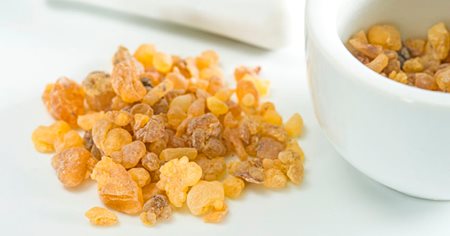
Reviving the Ancient Healing Wisdom of Frankincense (Boswellia)
Frankincense oil may receive most of the fame and glory, but the humble boswellia tree from which it is derived, can also create another powerful natural medicine. Oil and extracts of boswellia have been used for thousands of years to treat numerous health conditions.
While many of us are familiar with the meditative, cleansing, and enchanting aromas of incense, the very word itself contains the powerful natural medicine from which it is derived.
Frankincense, meaning “true incense” is a resin that comes from any tree species that belongs to the genus Boswellia. Spreading their branches through the Middle East, Africa, and India, this tree’s roots run deep in ancient usage and text. While all boswellia species can produce frankincense, Boswellia serrata is the supernal species that is adorned in traditional medicinal systems like Ayurveda and Unani for producing exceptional extracts.
Boswellia has a documented history of usage that dates back thousands of years, but it is quite possible this radical resin shared an evolutionary history with humans that greatly precludes our current estimates and archived paleoanthropological data. Just as fashion follows a circular cycle, with skinny jeans now the “newest rage”, so too is it time for a boswellia revival and resurgence.
Currently, there are 30 clinical studies on pubmed.gov, and 28 of those studies used B. serrata (the other 2 studies did not list a specific boswellia species in their abstract). With a strong modern-day scientific backing, coupled with traditional use, boswellia is a bright beacon pushing contemporary usage of natural medicines onward and upward.
A few of its best known therapeutic roles today include treating chronic health conditions like asthma, arthritis, cancer, and gastrointestinal issues. It has also been shown to reduce edema (swelling) from brain tumors after patients underwent radiotherapy [Kirste, 2011].
“RESULTS: Compared with baseline and if measured immediately after the end of radiotherapy and BS/placebo treatment, a reduction of cerebral edema of >75% was found in 60% of patients receiving BS and in 26% of patients receiving placebo (P = .023). These findings may be based on an additional antitumor effect. There were no severe adverse events in either group.” [Kirste, 2011]
According to the American Academy of Allergy, Asthma, and Immunology in just 8 years (from 2001-2009), the prevalence of asthma jumped from 20 million people to 25 million people. That trend only seems to be increasing and if we extrapolate the data to 2017 there will be 30 million people with asthma, which is almost 10% of the population.
Commonly used drugs, like inhaled corticosteroids or oral steroids may be effective, but at what cost? Serious long-term health consequences such as osteoporosis, cataracts, behavioral and mood changes, plus immunosuppression, are just to name a few [Dahl, 2006].
One of the reasons asthma is difficult to treat is because it involves an inflammatory enzyme pathway called the 5-LOX (arachidonate 5-lipoxygenase). Through a series of biochemical reactions, this enzyme produces substances called leukotrienes from the oxidation of lipid substrates, predominantly from arachidonic acid, a polyunsaturated omega-6 fatty acid [Safayhi, 2000]]. When leukotrienes are overly expressed, our immune system is excessively activated, and we enter a state of chronic inflammation, which can manifest as chronic diseases like asthma. One of the beautiful mechanisms by which boswellia exhibits its benefits is through the prevention of degradation and oxidation to these fatty acids, thus reducing the inflammatory changes in the first place.
Boswellia has also proven to be efficacious in other chronic illnesses like inflammatory bowel diseases. Collagenous colitis, which falls under the IBD umbrella, is characterized by chronic diarrhea and is typically treated with a polypharmacy approach. In a placebo-controlled, randomized, double-blind clinical study, B. serrata extract (BSE) was found to be superior in remission rates (63.6%) versus placebo (26.7%) after a six-week treatment [Madisch, 2007]. In a clinical study on chronic colitis, the remission rates were thirty percent higher in the boswellia group (14 out of 20 patients) versus the anti-inflammatory pharmaceutical drug sulfasalazine (4 out of 10 patients) [Gupta, 2001].
In a clinical study on breast cancer patients undergoing radiotherapy, a boswelia cream was found to significantly reduce the skin-damaging side effects [Togni, 2015]. Radiotherapy can cause extreme irritation, inflammation, itching, pain, and redness, which can severely alter a patient’s quality of life [Shaitelman, 2015]. Managing these disruptive side effects is typically done with steroids to reduce the immune response, but why risk the consequences when boswellia is a much safer alternative?
While boswellia extract may be a formidable force, so too are the volatile oils (essential oils) derived from the gummy resin. There are four main species of Boswellia from which high-quality frankincense oils are extracted: B. sacra, B. carteri, B. frereana, and B. serrata. While the chemical constituents may vary by species, in general, frankincense oil contains beneficial terpene compounds (limonene, alpha-pinene, beta-pinene, camphene, myrcene) [Woolley, 2012].
Human data may currently be limited on essential oil applications, but animal and cellular studies have elucidated some of the mechanisms responsible for these anti-cancer properties. Frankincense oil has demonstrated cytotoxic, apoptotic, and anti-proliferative properties against various cancer cell lines, including pancreatic cancer (which generally has an overall survival rate in humans of less than five years) [Ni, 2012].
Without applying reductionist principles to the innate wisdom of this plant, boswellia probably has countless ways by which it improves health and restore balance. Whether you prefer a boswellia extract or frankincense essential oil - caveat emptor (buyer beware) - as the purity and efficacy of products can vary greatly. Make sure to do your research and work with a company you know and trust.
© [11/22/2023] GreenMedInfo LLC. This work is reproduced and distributed with the permission of GreenMedInfo LLC. Want to learn more from GreenMedInfo? Sign up for the newsletter here //www.greenmedinfo.com/greenmed/newsletter.
------------------------------------------------------------------------------------------------
Pedagogy Education offers many courses for nurses wanting to learn more about holistic nursing!
- A Holistic Approach to Gut Health
- CBD 101: An Introductory Course
- Thyroid Gland Overview
- Essential Oils for Health
- Hashimoto's Thyroiditis From a Western Medicine and Holistic Perspective
- Healing the Healer
- Intravenous Nutrient Therapies: Myers’ Cocktail
- Probiotics
All of the above courses can be purchased through our Holistic Continuing Education Package at a discounted rate of 10% off!
Pedagogy's courses are available for purchase by the individual or facility. For individuals, register with us to create your username and password, click on the course title of interest and then click the Purchase button. For a complete listing of all our online continuing education courses, including the largest selection of infusion continuing education courses offered online, click here!
For organizations that would like to purchase education for their entire staff, email sales@pedagogyeducation.com and let us know the course(s) of interest and how many staff members you need to provide education for, and we will be happy to send you a price quote.

